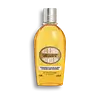What's inside
What's inside
 Key Ingredients
Key Ingredients

No key ingredients
 Benefits
Benefits

 Concerns
Concerns

 Ingredients Side-by-side
Ingredients Side-by-side

Vitis Vinifera Seed Oil
EmollientTipa-Laureth Sulfate
CleansingLaureth-3
EmulsifyingCaprylic/Capric Triglyceride
MaskingParfum
MaskingCocamide Mea
EmulsifyingPropylene Glycol
HumectantSorbitan Oleate
EmulsifyingPrunus Amygdalus Dulcis Oil
Skin ConditioningCitrus Aurantium Bergamia Fruit Oil
MaskingHelianthus Annuus Seed Oil
EmollientRosmarinus Officinalis Leaf Extract
AntimicrobialTocopherol
AntioxidantWater
Skin ConditioningLimonene
PerfumingCoumarin
PerfumingLinalool
PerfumingVitis Vinifera Seed Oil, Tipa-Laureth Sulfate, Laureth-3, Caprylic/Capric Triglyceride, Parfum, Cocamide Mea, Propylene Glycol, Sorbitan Oleate, Prunus Amygdalus Dulcis Oil, Citrus Aurantium Bergamia Fruit Oil, Helianthus Annuus Seed Oil, Rosmarinus Officinalis Leaf Extract, Tocopherol, Water, Limonene, Coumarin, Linalool
Water
Skin ConditioningSodium Cocoyl Isethionate
CleansingCocamidopropyl Betaine
CleansingAcrylates Copolymer
Parfum
MaskingCocamide Mipa
EmulsifyingGlycol Stearate
EmollientCocos Nucifera Oil
MaskingEuterpe Oleracea Fruit Oil
Skin ConditioningTheobroma Grandiflorum Seed Butter
Skin ConditioningCoconut Acid
CleansingCaprylyl Glycol
EmollientSodium Isethionate
CleansingGuar Hydroxypropyltrimonium Chloride
Skin ConditioningMagnesium Sulfate
Sodium Hydroxide
BufferingEthylhexylglycerin
Skin ConditioningSodium Phytate
Caramel
Cosmetic ColorantPhenoxyethanol
PreservativeCI 19140
Cosmetic ColorantBenzyl Salicylate
PerfumingHydroxycitronellal
PerfumingCoumarin
PerfumingLimonene
PerfumingWater, Sodium Cocoyl Isethionate, Cocamidopropyl Betaine, Acrylates Copolymer, Parfum, Cocamide Mipa, Glycol Stearate, Cocos Nucifera Oil, Euterpe Oleracea Fruit Oil, Theobroma Grandiflorum Seed Butter, Coconut Acid, Caprylyl Glycol, Sodium Isethionate, Guar Hydroxypropyltrimonium Chloride, Magnesium Sulfate, Sodium Hydroxide, Ethylhexylglycerin, Sodium Phytate, Caramel, Phenoxyethanol, CI 19140, Benzyl Salicylate, Hydroxycitronellal, Coumarin, Limonene
 Reviews
Reviews

Ingredients Explained
These ingredients are found in both products.
Ingredients higher up in an ingredient list are typically present in a larger amount.
Coumarins are a group of substances found naturally in plants. There are over 1300 types of coumarins identified. It has a natural vanilla scent.
Coumarin is an identified EU known allergy, meaning it may cause an allergic reaction when applied to the skin.
In many countries, coumarin is banned as a food additive. However, it can be found in soaps, tobacco products, and some alcohol drinks.
Plants use coumarins as a chemical defense. Some plants that have coumarins include lavender, tonka beans, and yellow clovers.
Learn more about CoumarinLimonene is a fragrance that adds scent and taste to a formulation.
It's found in the peel oil of citrus fruits and other plants such as lavender and eucalyptus. The scent of limonene is generally described as "sweet citrus".
Limonene acts as an antioxidant, meaning it helps neutralize free radicals.
When exposed to air, oxidized limonene may sensitize the skin. Because of this, limonene is often avoided by people with sensitive skin.
The term 'fragrance' is not regulated in many countries. In many cases, it is up to the brand to define this term. For instance, many brands choose to label themselves as "fragrance-free" because they are not using synthetic fragrances. However, their products may still contain ingredients such as essential oils that are considered a fragrance.
Learn more about LimoneneParfum is a catch-all term for an ingredient or more that is used to give a scent to products.
Also called "fragrance", this ingredient can be a blend of hundreds of chemicals or plant oils. This means every product with "fragrance" or "parfum" in the ingredients list is a different mixture.
For instance, Habanolide is a proprietary trade name for a specific aroma chemical. When used as a fragrance ingredient in cosmetics, most aroma chemicals fall under the broad labeling category of “FRAGRANCE” or “PARFUM” according to EU and US regulations.
The term 'parfum' or 'fragrance' is not regulated in many countries. In many cases, it is up to the brand to define this term.
For instance, many brands choose to label themselves as "fragrance-free" because they are not using synthetic fragrances. However, their products may still contain ingredients such as essential oils that are considered a fragrance by INCI standards.
One example is Calendula flower extract. Calendula is an essential oil that still imparts a scent or 'fragrance'.
Depending on the blend, the ingredients in the mixture can cause allergies and sensitivities on the skin. Some ingredients that are known EU allergens include linalool and citronellol.
Parfum can also be used to mask or cover an unpleasant scent.
The bottom line is: not all fragrances/parfum/ingredients are created equally. If you are worried about fragrances, we recommend taking a closer look at an ingredient. And of course, we always recommend speaking with a professional.
Learn more about ParfumWater. It's the most common cosmetic ingredient of all. You'll usually see it at the top of ingredient lists, meaning that it makes up the largest part of the product.
So why is it so popular? Water most often acts as a solvent - this means that it helps dissolve other ingredients into the formulation.
You'll also recognize water as that liquid we all need to stay alive. If you see this, drink a glass of water. Stay hydrated!
Learn more about Water